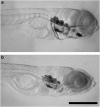Zebrafish: an emerging technology for in vivo pharmacological assessment to identify potential safety liabilities in early drug discovery
- PMID: 18552866
- PMCID: PMC2492106
- DOI: 10.1038/bjp.2008.249
Zebrafish: an emerging technology for in vivo pharmacological assessment to identify potential safety liabilities in early drug discovery
Abstract
The zebrafish is a well-established model organism used in developmental biology. In the last decade, this technology has been extended to the generation of high-value knowledge on safety risks of novel drugs. Indeed, the larval zebrafish appear to combine advantages of whole organism phenotypic assays and those (rapid production of results with minimal resource engagement) of in vitro high-throughput screening techniques. Thus, if appropriately evaluated, it can offer undeniable advantages in drug discovery for identification of target and off-target effects. Here, we review some applications of zebrafish to identify potential safety liabilities, particularly before lead/candidate selection. For instance, zebrafish cardiovascular system can be used to reveal decreases in heart rate and atrial-ventricular dissociation, which may signal human ether-a-go-go-related gene (hERG) channel blockade. Another main area of interest is the CNS, where zebrafish behavioural assays have been and are further being developed into screening platforms for assessment of locomotor activity, convulsant and proconvulsant liability, cognitive impairment, drug dependence potential and impaired visual and auditory functions. Zebrafish also offer interesting possibilities for evaluating effects on bone density and gastrointestinal function. Furthermore, available knowledge of the renal system in larval zebrafish can allow identification of potential safety issues of drug candidates on this often neglected area in early development platforms. Although additional validation is certainly needed, the zebrafish is emerging as a versatile in vivo animal model to identify off-target effects that need investigation and further clarification early in the drug discovery process to reduce the current, high degree of attrition in development.
Figures




References
-
- Airhart MJ, Lee DH, Wilson TD, Miller BE, Miller MN, Skalko RG. Movement disorders and neurochemical changes in zebrafish larvae after bath exposure to fluoxetine (PROZAC) Neurotoxicol Teratol. 2007;29:652–664. - PubMed
-
- Alderton WK, Kimber GM, Richards FR, Strang I, Redfern WS, Winter MJ, et al. Validation of an optomotor method for assessment of visual function in zebrafish larvae (poster) Safety Pharmacology Society Annual Meeting 2007Edinburgh, UK; 20–21.September 2007
-
- Alestrom P, Holter JL, Nourizadeh-Lillabadi R. Zebrafish in functional genomics and aquatic biomedicine. Trends Biotechnol. 2006;24:15–21. - PubMed
-
- Antkiewicz DS, Burns CG, Carney SA, Peterson RE, Heideman W. Heart malformation is an early response to TCDD in embryonic zebrafish. Toxicol Sci. 2005;84:368–377. - PubMed
Publication types
MeSH terms
LinkOut - more resources
Full Text Sources
Other Literature Sources
Medical

